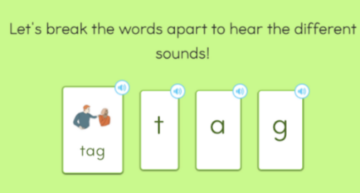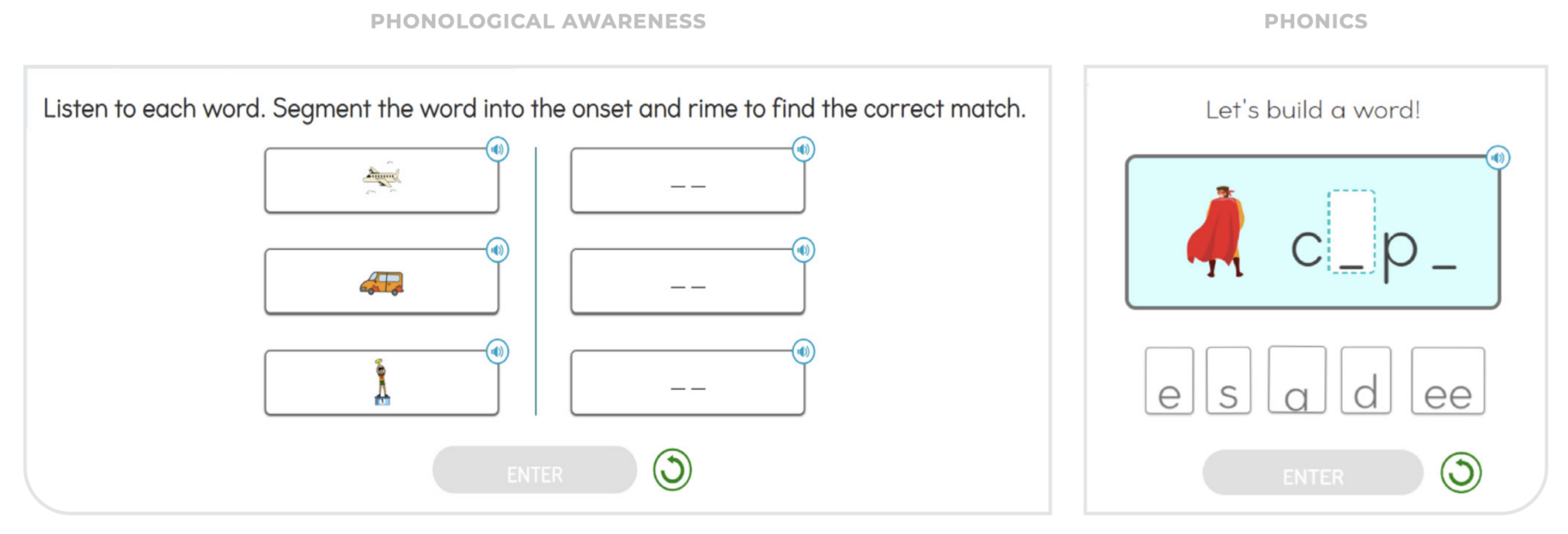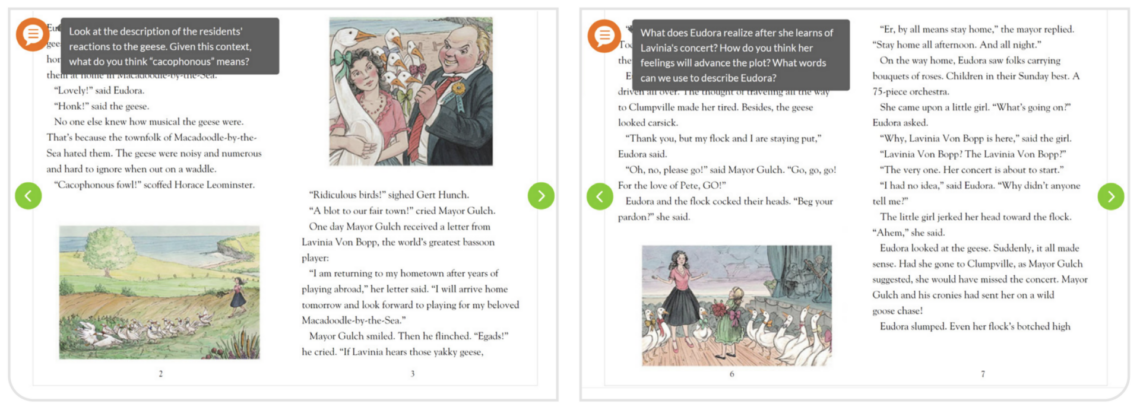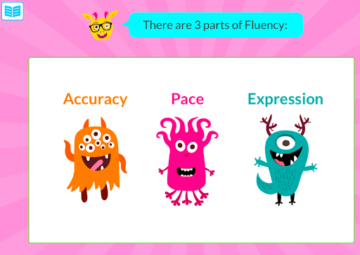BookNook is an online collaborative learning model that offers reading intervention through reading lessons that include synchronous instruction, interactive activities, group discussion, and collaboration opportunities. Grounded in the science of reading, BookNook tutoring is versatile in being able to fit a school’s needs. It can be used for reading intervention and, while it usually takes place during the school day, tutoring services are also available before or after school. Tutoring can occur either one-on-one or in small groups, and tutors can be either in-person using school staff or virtual using BookNook tutors.
BookNook’s reading curriculum comprises lessons that support the development of skills in phonological awareness, phonics, fluency, vocabulary, and comprehension. With more than 850 lessons—with some lessons available with Spanish supports—BookNook offers synchronous, impactful, scalable, and engaging tutoring designed to enhance K–-8 reading achievement. These tutoring sessions occur 2–3 times a week for 30 minutes each. BookNook Overview
BookNook is currently used in more than 2,700 schools across 40 different states. On average, students who received 20+ sessions of tutoring outperformed their peers by more than a quarter standard deviation in just 10 weeks.
What Makes This Model Innovative?
Rigorous Learning
High Expectations with Unlimited Opportunities
Customization
Goals
BookNook’s mission is to ensure equitable access to rigorous and engaging reading instruction through technology innovation. BookNook provides a unique solution to the early reading opportunity gap by pairing an online, synchronous instruction tool with a student-centered tutoring model.
Higher Reading Achievement
Students experience growth in reading engagement and proficiency, which leads them to pursue advanced opportunities for expanding their achievement in reading.
Lifelong Learning and Reading
Students improve their self-confidence, motivation, and interest in reading, which leads them to value lifelong learning and reading.
Experience
BookNook is a high-dosage tutoring reading program that can serve as an intervention (tier 2 and tier 3) or acceleration tool as a supplement to a school’s core literacy curriculum. It uses a synchronous teaching platform and a flexible learning model grounded in the science of reading to deliver high-dosage tutoring services and help students learn at an accelerated pace.
Schools determine which students should participate in BookNook tutoring based on existing assessment data (e.g., benchmark reading level data, standardized testing data). Students then meet with the same tutor in one-on-one or small group settings to build relationships and to allow the tutor to develop a deep understanding of each student’s strengths and skill gaps. Whether tutors are virtual or in-person, students work through BookNook’s virtual platform to participate in their lessons.
Lessons feature:
- A standards-aligned curriculum: All lessons are aligned to standards and support student practice and learning in these standards. BookNook Learning Standards Overview
- Vetted, complex, diverse texts: At the core of every BookNook lesson is a text. Text selection criteria include quantitative and qualitative features of text complexity, standard alignment, topic coverage, and diverse and inclusive representation.
- Multisensory activities: Students engage in different multisensory activities, such as matching audio vocabulary words to visual definitions.
- Spanish language support: Some lessons provide Spanish written translations and audio.
- Multi-tiered systems of support (MTSS): BookNook lessons can be used to support MTSS initiatives and interventions.
BookNook’s model features three types of lessons to help students learn to read: Phonological Awareness/Phonics, Comprehension, and Fluency.
BookNook’s Phonological Awareness/Phonics Lessons support students in building, practicing, and retaining foundational skills in both the phonological awareness and the phonics components of the science of reading. These lessons follow the same flow each time: Skill Introduction, Skill Practice, Foundational Skills Text, and Formative Assessment.
 Skill Introduction: Lessons begin with the Skill Introduction where students are taught the skill or standard that the lesson is aligned to. Tutors present the skill and relevant examples for students to both see and hear, which provides the foundations needed for students to then practice the skill. For example, students may be introduced to consonant-vowel-consonant words, such as “cat” or “big,” and will be prompted to break the words apart to hear the different sounds.
Skill Introduction: Lessons begin with the Skill Introduction where students are taught the skill or standard that the lesson is aligned to. Tutors present the skill and relevant examples for students to both see and hear, which provides the foundations needed for students to then practice the skill. For example, students may be introduced to consonant-vowel-consonant words, such as “cat” or “big,” and will be prompted to break the words apart to hear the different sounds.
Skill Practice: Students then move to the Skill Practice, where they have the opportunity to apply the skill or standard of the lesson through multiple, engaging practice activities. These practice activities help students practice the skill in many different ways to support skill retention and mastery. Students engage in 2–5 different practice activity types depending on the lesson.

Foundational Skills Text: Next, in the Foundational Skills Text section, students are able to practice the skill they’re focusing on with a text that incorporates a high number of words aligned to that skill. These texts integrate the components of phonics, fluency, and text reading comprehension skills through the authentic practice reading.
Formative Assessment: Lastly, each Phonological Awareness/Phonics Lesson ends with a Formative Assessment, which helps to provide an understanding of students’ progress toward mastery of the lesson’s standard through 3–5 aligned questions.

Comprehension Lessons are designed to support students in practicing and building skills in the vocabulary and comprehension components of the science of reading. Each Comprehension Lesson follows the same flow: Vocabulary Activities, Text Reading + Discussion, Comprehension Activity, and Formative Assessment.
Vocabulary Activities: Each lesson starts with Vocabulary Activities; this instruction is important because of the impact a lack of vocabulary understanding can have on a student’s comprehension of the text. The vocabulary prioritized for focus in this section are tier 2 and/or tier 3 words that are essential to the comprehension of the text. The goal of the vocabulary work is that students have an understanding of the words when they are encountered while reading the text of the lesson. In alignment with this goal, students have multiple opportunities to engage with the words and their meaning. Students are taught vocabulary words in a scaffolded exposure.
Text Reading + Discussion: The transition from vocabulary to comprehension work begins with the Text Reading + Discussion of an authentic text. This read-through supports students in building a foundational comprehension of the text and is essential to help students engage in higher-level thinking about the text. The discussion stopping points also include questions that are aligned to the standard of the lesson. Therefore, students are engaging in discussion and critical thinking aligned to the skill(s) and standard of the lesson as well. Strategies implemented during a read-through support active engagement and provide opportunities for students to grapple with what they are reading, as opposed to passively reading the text. Discussion stopping points encourage strategies such as:
- Activating prior knowledge or predicting
- Synthesizing information or retelling
- Participating in a range of conversations and collaboration, building on others’ ideas and expressing their own
- Determining the meaning of unknown and multiple-meaning words and phrases by using context clues and analyzing meaningful word parts
- Locating and recalling
- Integrating and interpreting
- Critiquing and evaluating

Comprehension Activity: Students then engage in a Comprehension Activity that includes intentional work around foundational comprehension skills such as main ideas, themes, summarizing, retelling, and sequencing.
Formative Assessment: Each Comprehension Lesson concludes with a 3–5-question Formative Assessment. Student performance on these questions helps to provide an understanding of their progress toward mastery of the lesson’s standard.
BookNook’s Fluency Lesson is designed to provide students the opportunity to practice and build their skills in oral reading fluency, thus supporting work in the fluency component of the science of reading. Fluency Lessons follow the same flow each time: Fluency Introduction, Exemplar Fluency Activity, “What’s Wrong?” Activity, and Student Fluency Read.
 Fluency Introduction: During the Fluency Introduction, students review three components of fluency—accuracy, pace, and expression—and their definitions.
Fluency Introduction: During the Fluency Introduction, students review three components of fluency—accuracy, pace, and expression—and their definitions.
Exemplar Fluency Activity: Students then do an Exemplar Fluency Activity, in which they listen to an exemplar reading of a passage that demonstrates strong accuracy, pace, and expression. Students later have the opportunity to read the same passage aloud and practice the same techniques they heard in the exemplar reading.
“What’s Wrong?” Activity: The “What’s Wrong?” Activity provides students the opportunity to listen to and monitor non-exemplar fluency readings. Students identify the strengths and weaknesses in what they hear in order to improve their self-monitoring skills.
Student Fluency Read: Finally comes the Student Fluency Read, where students read a passage aloud while the tutor notes any errors. The BookNook algorithm uses these notes to calculate the student’s accuracy and pace.
Supporting Structures
BookNook can be implemented into a school’s existing design but will require some shifts across various school structures to allow for frequent and consistent tutoring for students. Before beginning partnership, BookNook uses a rubric to evaluate a school’s readiness to integrate tutoring. Evaluation Tool for High-Impact Tutoring
Implementing BookNook involves using its high-quality instructional tutoring platform alongside existing literacy curriculum.
BookNook’s curriculum is grounded in the science of reading and composed of three types of lessons to support students in building reading proficiency: Phonological Awareness/Phonics Lessons, Comprehension Lessons, and Fluency Lessons (see experience section). BookNook Lesson Overviews (Grades 1, 3, and 6) BookNook Curriculum Analysis Guide
After participating in school- or district-administered benchmark assessments, students begin their practice in BookNook lessons, then continue to complete formative assessments over the course of each lesson. The BookNook platform automatically grades and collects data on students’ performance to monitor student reading progress.
Students participate in a set number of lessons as determined by the school or district. Though it is up to the school or district, it is recommended that students still exhibiting literacy skill gaps participate in another cohort to continue tutoring.
Strong relationships, both within tutoring groups and with the tutor, are key to supporting students.
Tutors work to foster deep, trusting relationships with students so that students feel safe taking the risks necessary to learn and can ask questions to build toward strengthening reading skills. Tutors should leverage check-ins at the beginning of lessons to get to know students personally and understand the mindset and headspace they’re bringing to the day’s lesson. Additionally, tutors should celebrate reading growth to continue building positive relationships and associations with reading.
Additionally, students alternate between independent work and collaborative conversations during the BookNook reading activities when prompted by the tutor. During this small-group work, students learn to work together toward a shared goal.
Trained tutors provide instruction to students either in-person or virtually.
BookNook’s curriculum includes step-by-step directions for each lesson that support tutors through the lessons. Because of this, tutors do not need to have a background in literacy in order to lead a lesson.
Schools can opt into virtual tutoring through BookNook (Virtual Tutor Service) or in-person tutoring using their current support staff and teachers (In-House Delivery).
In the Virtual Tutor Service delivery format, BookNook hires and trains tutors who have previously taught academic subjects to K–12 students and have experience with tutoring, are currently enrolled in a teaching program, or have 3+ years of tutoring experience. All tutors go through BookNook Tutor Certification and may participate in ongoing professional development. BookNook tutors reflect the diverse community that they serve.
In the In-House Delivery format, BookNook provides the online platform and curriculum to the school. Districts must participate in an initial BookNook-led virtual training for their school tutors. Additional training is available, if desired. In-school tutors, who could be teachers, support staff, parents, or other volunteers, then deliver tutoring using BookNook’s platform, lessons, and prompts to support the implementation of high-quality reading lessons.
BookNook’s high-impact tutoring program requires frequent and consistent tutoring.
In order for BookNook’s programming to be successful, tutoring sessions must occur 2–3 times per week for 30 minutes each. It is recommended that tutoring occur at some point during the school day, but tutoring can also take place before or after school.
BookNook can take place in any quiet, available school space.
To minimize distractions, lessons should be administered in any quiet space, such as the back of the classroom or a separate room with supervision. Checklist for Virtual Tutoring Success
Schools must have access to appropriate devices and BookNook’s teaching platform in order to implement tutoring sessions.
BookNook’s tutoring platform automatically syncs devices, providing a collaborative student–teacher experience for both in-person and virtual instruction. The platform enables real-time one-on-one or small-group tutoring instruction for students in grades K–8. Each lesson provides thoughtful support at every step of the process, allowing tutors of all backgrounds to feel confident leading instruction.
In order to use the BookNook platform and move through the reading lessons, the school building needs stable, high-speed internet and each student needs their own device, such as a laptop, ChromeBook, or iPad. Individual sets of headphones are also recommended.
The cost of BookNook varies based on myriad factors for each school district.
BookNook’s pricing is tailored to fit the specific requirements of each district, taking into account factors such as number of students using the platform, number of tutoring sessions needed, and the utilization of BookNook’s tutors.
BookNook also provides a discount for platform access that is determined by the proportion of students in the district who are enrolled in free or reduced-price lunch plans, ensuring equal opportunity access.
Implementing BookNook involves using its high-quality instructional tutoring platform alongside existing literacy curriculum.
BookNook’s curriculum is grounded in the science of reading and composed of three types of lessons to support students in building reading proficiency: Phonological Awareness/Phonics Lessons, Comprehension Lessons, and Fluency Lessons (see experience section). BookNook Lesson Overviews (Grades 1, 3, and 6) BookNook Curriculum Analysis Guide
After participating in school- or district-administered benchmark assessments, students begin their practice in BookNook lessons, then continue to complete formative assessments over the course of each lesson. The BookNook platform automatically grades and collects data on students’ performance to monitor student reading progress.
Students participate in a set number of lessons as determined by the school or district. Though it is up to the school or district, it is recommended that students still exhibiting literacy skill gaps participate in another cohort to continue tutoring.
Strong relationships, both within tutoring groups and with the tutor, are key to supporting students.
Tutors work to foster deep, trusting relationships with students so that students feel safe taking the risks necessary to learn and can ask questions to build toward strengthening reading skills. Tutors should leverage check-ins at the beginning of lessons to get to know students personally and understand the mindset and headspace they’re bringing to the day’s lesson. Additionally, tutors should celebrate reading growth to continue building positive relationships and associations with reading.
Additionally, students alternate between independent work and collaborative conversations during the BookNook reading activities when prompted by the tutor. During this small-group work, students learn to work together toward a shared goal.
Trained tutors provide instruction to students either in-person or virtually.
BookNook’s curriculum includes step-by-step directions for each lesson that support tutors through the lessons. Because of this, tutors do not need to have a background in literacy in order to lead a lesson.
Schools can opt into virtual tutoring through BookNook (Virtual Tutor Service) or in-person tutoring using their current support staff and teachers (In-House Delivery).
In the Virtual Tutor Service delivery format, BookNook hires and trains tutors who have previously taught academic subjects to K–12 students and have experience with tutoring, are currently enrolled in a teaching program, or have 3+ years of tutoring experience. All tutors go through BookNook Tutor Certification and may participate in ongoing professional development. BookNook tutors reflect the diverse community that they serve.
In the In-House Delivery format, BookNook provides the online platform and curriculum to the school. Districts must participate in an initial BookNook-led virtual training for their school tutors. Additional training is available, if desired. In-school tutors, who could be teachers, support staff, parents, or other volunteers, then deliver tutoring using BookNook’s platform, lessons, and prompts to support the implementation of high-quality reading lessons.
BookNook’s high-impact tutoring program requires frequent and consistent tutoring.
In order for BookNook’s programming to be successful, tutoring sessions must occur 2–3 times per week for 30 minutes each. It is recommended that tutoring occur at some point during the school day, but tutoring can also take place before or after school.
BookNook can take place in any quiet, available school space.
To minimize distractions, lessons should be administered in any quiet space, such as the back of the classroom or a separate room with supervision. Checklist for Virtual Tutoring Success
Schools must have access to appropriate devices and BookNook’s teaching platform in order to implement tutoring sessions.
BookNook’s tutoring platform automatically syncs devices, providing a collaborative student–teacher experience for both in-person and virtual instruction. The platform enables real-time one-on-one or small-group tutoring instruction for students in grades K–8. Each lesson provides thoughtful support at every step of the process, allowing tutors of all backgrounds to feel confident leading instruction.
In order to use the BookNook platform and move through the reading lessons, the school building needs stable, high-speed internet and each student needs their own device, such as a laptop, ChromeBook, or iPad. Individual sets of headphones are also recommended.
The cost of BookNook varies based on myriad factors for each school district.
BookNook’s pricing is tailored to fit the specific requirements of each district, taking into account factors such as number of students using the platform, number of tutoring sessions needed, and the utilization of BookNook’s tutors.
BookNook also provides a discount for platform access that is determined by the proportion of students in the district who are enrolled in free or reduced-price lunch plans, ensuring equal opportunity access.
Supports Offered
BookNook offers the following supports to help you implement their approach.
BookNook Tutoring
Cost Associated
BookNook Tutoring includes access to the tutoring platform, curriculum, and professional development (PD) sessions for educators as they use the platform. Each PD features a different topic at a different point in program implementation, including Launch Sessions and Using Data to Inform Instruction. BookNook Professional Development Overview
BookNook offers a Virtual Tutor Service (with BookNook tutors) and In House Delivery (in-person tutoring with school staff).
Reach
Impact
BookNook’s high-impact tutoring leads to far-reaching impact and reading growth for participating students. 2022-2023 Annual Impact Report
In a randomized controlled study, students who received BookNook tutoring significantly outperformed their peers who did not receive tutoring. BookNook-Rocketship Results Overview
- After a 10-week study period, students who completed 20 or more BookNook sessions (the recommended dosage) outperformed their peers who did not participate in any BookNook tutoring sessions by 0.26 standard deviations. In other words, a student at the 50th percentile would be expected to advance nearly 10 percentile points on the end-of-year reading test.
- Overall, students participating in BookNook tutoring sessions (regardless of number of sessions) outperformed their peers by approximately 0.05 standard deviations, which means that for a student at the 50th percentile, being assigned to receive BookNook resulted in a 2 percentile point improvement on the end-of-year reading test.
Students who participated in BookNook tutoring demonstrated significant accelerated reading growth. 
- Over the course of the school year, the percentage of students using BookNook across grades K–8 engaging in lessons below grade level significantly reduced from 89.9% at the beginning of the program to 71.4%.
- The BookNook platform helped close the achievement gap and increased the number of students who are engaging in lessons on or above grade level from 9.7% to 24%.
- Though BookNook has historically been used for students in need of reading intervention, it can lead to growth for all readers: the number of students engaging in lessons above grade level soared from just 0.4% to 4.7% during the ’22-’23 school year.
Students enjoy participating in their BookNook tutoring sessions and consequently report positive feelings about reading.
- 89% of students reported a positive experience during their BookNook session.
Parents and guardians are also very satisfied with BookNook tutoring and the reading progress they are seeing in their children.
- In 2023, 88% of parents in Prince George’s County Maryland School District said that they felt BookNook helped their child.
“I LOVE BookNook! The sessions are the highlight of his school week! He typically does NOT like to read at all during his classes. In fact, he struggles with reading and he will tell you that Reading is his least favorite subject. To my surprise, he is eager to attend his BookNook tutoring sessions. He actually reminds me that it is time for him to log on.” – Parent, Prince George’s County Public Schools



